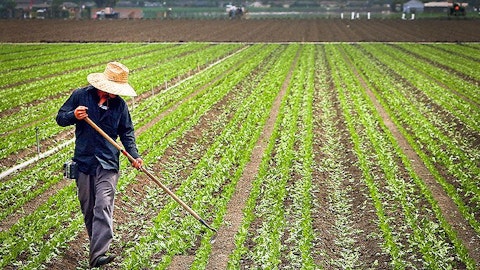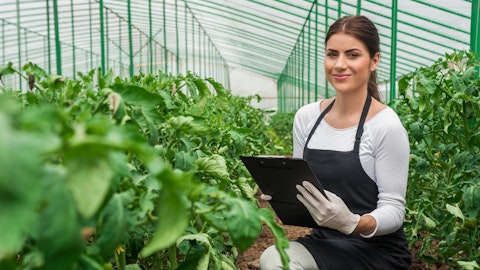So, making sure that we’re manufacturing to the plans that we intend and that those plans are informed by the commercial forecasts of the business. Those are some examples of KPIs that we’re working on. And then also as I said, driving these KPIs to the business units and from the business units into those key stakeholders, the roles that in the organizations that are responsible for each one of those. Not something necessarily that’s new, but certainly much more exhaustive process. And it is something, as Eric just mentioned, that I’m working on with the presidents of the business presently.
Scott Fortune: And then one last quick one for me. Sorry about that, but just wanted to step through, provide a little bit of color. I know you said the different geographies, the U.S. is doing well here. You mentioned much in Latin America. Just kind of unpack 2024 as some of the pressures still remain in South America and Latin America, which doesn’t affect you as much, but just kind of help us understand the strength in different geographies and where there might be some pressure still?
Unidentified Company Representative: Eric Wintemute Yes. So Mexico is very solid. Certainly there is generic pressure in all the markets. But we do have some kind of unique products in the Mexico. And there were inventories, I mean, particularly kind of globally if you look at the broad application of herbicides, I think that probably a big flood. There were certain insecticides that I think were loaded up, got into the generic world. Central America, we probably had more generic pressure there where we saw products that as the Chinese price of a lot of the commodity products came down, we saw some pressure certainly on inventories that we had. And not as much in Brazil, because Brazil we have predominantly was kind of fruits and veggie business that expanded into corn and soybeans with counter, but they are not sitting with generic pressure as much.
From a timing standpoint, the destocking, that I think was universal. I think every market that people were definitely have been sort of watching the inventory that we’re selling. But again, as we said, [indiscernible] question.
Operator: And our next question comes from Chris Kapsch with Loop Capital Markets. Please state your question.
Chris Kapsch: I have a few questions. So, one regarding the outlook for 2024. Given that you had these two key products, Aztec, Dacthal, that were impacted by absence of availability of actives last year. Just curious about what the expectation is for those products baked into your overall ’24 expectation? Would you expect just a normal demand environment or will you see outsized growth because of restocking of those products throughout the channel in 2024? Any color there?
Eric Wintemute: Both, I mean, we started selling Aztec in Q3 and Q4. Part of that was building back some inventories because inventories were down 5% or somewhere in that range. We did have good demand. We continue to have good demand now as the season is unfolding. We are not seeing any inventory build. We would expect to have strong second half of the year as well. That goal was pretty much completely gone. We did and do have ongoing orders. We haven’t filled all the orders yet, but we did have been supplying between fourth quarter and first quarter, a fair amount. We are expecting demand does look strong going forward. The product was growing for us. And so, outlook looks good certainly so far. I think we are looking at normalized volumes as we move forward. That said, as corn root worm pressure, I think the Aztec is kind of the key product where pressure is heavy. And so, we have grown, we grow, I guess, with the corn rootworm pressure that’s in the field.
Chris Kapsch: Got it. That’s helpful. And then on the Pathfinder and the focus on 15% EBITDA margin 2026. Curious if that bogey, if you will, is based on the portfolio as it exists today? Or is there any instances where you’re looking at a product line or a suite of products that you just structurally can’t see us getting there and therefore might be subject to, I don’t know, rationalization? Or is this sort of improvement expected to be kind of across the portfolio by 2026?
Eric Wintemute: We’re did not bake-in any acquisitions per se into the model. We do have ongoing projects that we do in our core business, both through licensing and combination products that are part of that. Of course, as we expand the products in the portfolio for SIMPAS, those are targets that we’ve identified going forward for the next couple of years. But as I said, we did not bake into the model.
Chris Kapsch: Just as a follow-up, what about rationalizing products, meaning, like just products that are lower margin dragging on the overall mix and don’t really see a pathway to get to that or to help the overall company get to the 15%? And then what also is embedded in the growth rates of your the more novel growth platforms and maybe just more generally, when might you expect to update the growth targets for those product suites? Thank you.
Eric Wintemute: So, with regard to product rationalization, yes, I mean, we are as part of what we’re identifying, we’re identifying quality of business, return on working capital. So those products that do have lower margins are won’t be emphasized the way we want to focus our team on our higher margin products and grow those. So that is part of the process that we’re going to improve both our manufacturing outputs as far as yield and then combine that with working on purchasing power to lower our cost of goods. And right now, it is pretty good time as we saw prices spike in ’22 during the pandemic. We are seeing a softening back on a number of these core intermediates that we use and with that, that’s part of improving our margins as well.


